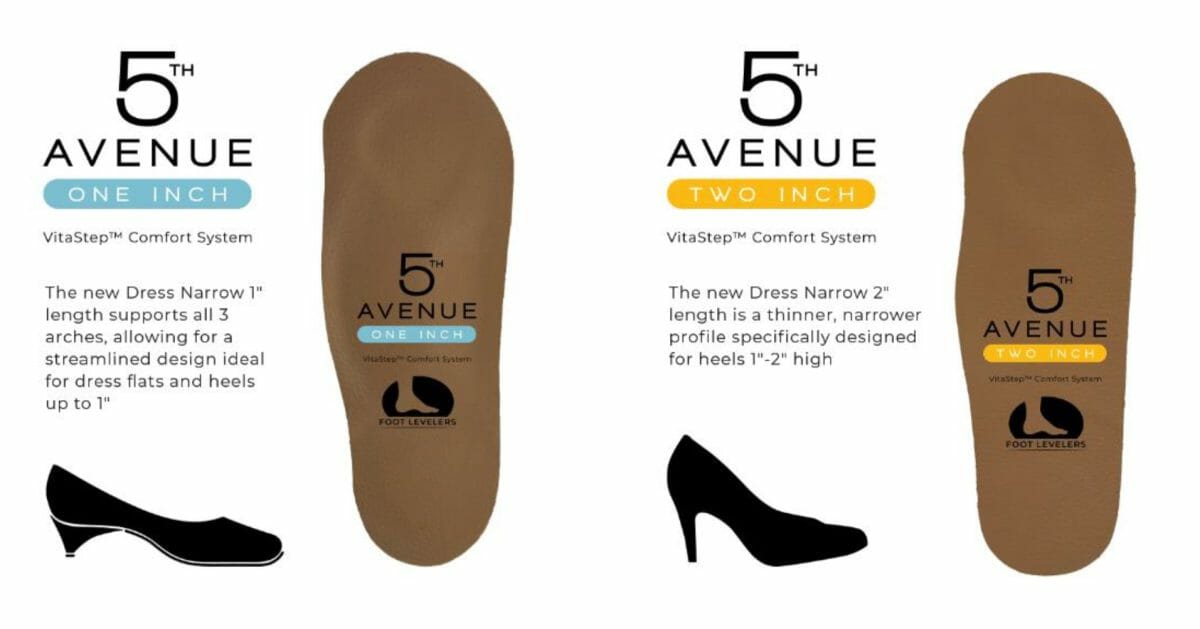Foot Levelers, the world’s leading provider of hand-crafted custom orthotics and serving multi-disciplinary professionals and clinicians is proud to share with Medical Device News Magazine our new and improved custom-crafted custom, flexible orthotics – developed by women, for women. These custom, flexible orthotics resolve the vast differences in foot structure between women and men, relieving the discomfort, pain and fatigue that results from high-fashion footwear and avoiding serious foot health issues down the line.
Women’s bodies are vastly different from men’s – right down to the foot. For this reason, the 5th Avenue Custom Collection was re-designed to be more responsive to a woman’s unique foot structure. As with all Foot Levelers custom-crafted orthotics, which are fabricated from a weightbearing cast or scan and exclusively available from Foot Levelers, this innovative design stabilizes all three arches of the foot. This results in healthy balance and alignment for total body health.
Many women’s shoe designs, including high heels, pointed toes and a narrow last, fail to account for these differences in women’s feet. This new custom-crafted orthotic enables women to wear their favorite shoes without compromising their health.
Male v. Female: Vast Differences in Foot Structure
Women’s feet differ from men with regards to their shape and size and their knee alignments and gait styles are also very dissimilar. Joint problems and symptom patterns differ, as well, so orthotic solutions need to be specific. As women age, their foot problems tend to become more severe, often resulting in significant disability and problems with walking. Appropriate lower extremity treatment and spinal support depend on differentiating each woman’s needs.
- Women tend to have a narrower heel in relation to the forefoot
- A woman’s forefoot is wider and causes the biomechanical forces on the foot to be distributed differently
- A woman’s foot is narrower overall than a man’s foot relative to its length
- The female Achilles tendon is smaller in circumference and strength, but also shorter
While many lower extremity conditions in women are associated with or result from abnormal biomechanics of the feet, unhealthy shoe designs, such as high heels, only increase and accelerate the risk of developing bunions, hammer toes, callus formation, interdigital neuromas and metatarsalgia that can come with age. As a result, orthotics for women should be designed to support the longitudinal and anterior transverse arches to provide metatarsal passing and to limit excessive heel motion.
Studies confirm that small, dense metatarsal arch pads positioned more distally reduce the pressures on the metatarsal heads and can decrease plantar pressures and reduce pain. During the study, quantitative measurements of dynamic peak pressures for 10 asymptomatic subjects with and without metatarsal pads were made using the pedobarograph. Female volunteers had a reduction in peak metatarsal pressures from 12% to 60% when a small metatarsal pad was appropriately applied to the foot.
Every woman needs to wear shoes that have been designed for the gender-specific needs of the female foot. This means a shoe that is narrow at the heel and widens substantially at the forefoot. It should have a short, but wide toe box, and some mechanism (such as laces or straps) to keep the narrow heel in place during gait. Unfortunately, this describes very few of the shoes currently bought and worn by women in our society. Traditional high heels and pumps do not fall into the healthy shoe category.
Orthotics for women should be designed to support the longitudinal and anterior transverse arches, to provide metatarsal padding, and to limit excessive heel motion. One study of patients with metatarsalgia found that custom-made orthotics with a “metatarsal dome” decreased the plantar pressures by an average of 17% and reduced the reported pain 71%.
Benefits of Newly Designed Custom-Crafted Orthotics
In addition to the many new features that will increase support and comfort, there are additional advantages to adding these new custom-crafted flexible orthotics to a woman’s wardrobe. They are available in two styles: for shoes with heels up to one inch and heels between one and two inches.

- Shorter: The 5th Avenue for 1″ has been slightly shortened and narrowed for a better, low-profile fit while still providing maximum comfort, support and stabilization.
- More Comfortable: Thick layer of Propacel™ in the toe area has been replaced with the streamlined VitaStep™ Comfort System for both the 1” and 2” styles, providing maximum support and a better fit in a greater assortment of women’s shoes, including narrower ones with smaller toe boxes.
- Softer: The Fifth Avenue Collection maintains the luxurious Lambson™ vegan leather top cover
- More Shock Absorption: Because women need unique support in the heels, the 5th Avenue custom, flexible orthotics contain a Zorbacel® heel pad for extra shock absorption and comfort while maintaining proper support for a narrow fitting shoe.
- Dynamic Response System™ (DRS) Now Standard Feature: DRS is now a standard feature rather than an add-on option. This proprietary arch material acts like a suspension system and enhances stability by responding to variable loads and uneven terrain.
Custom-Crafted Flexible Orthotics vs. “Off-the-Shelf” Products
Understanding the Difference
Over-the-counter insoles and inserts from the supermarket or drugstore fall woefully short in providing relief – for women as well as for men. One-size-fits-all insoles and inserts fail to account for a unique foot and may not fit properly in a shoe – whether it’s a woman’s high heels or casual shoes or a man’s dress shoes or work boots.
Custom flexible orthotics are clearly a better option since they are specifically made for individual use, are fabricated to support not simply walking but also to improve balance, walking adaptability and forward movement. When these objectives are met, the custom orthotic provides the support that is needed for the feet and for overall body health.
Addressing Foot Dysfunction
Most people never think of their feet as a contributing factor for back pain, although foot dysfunction is often the root cause of many spine problems and the accompanying pain – especially issues related to wearing high heels or pointed toe shoes. Today, there is growing recognition that the feet are the foundation of the body and the kinetic chain that is responsible for optimal functioning of the knees, hips and back.
Constrictive shoes accentuate the problems of high heels, and they create problems of their own. A study of 356 healthy women found that 88% were wearing shoes that were significantly smaller than their feet.11 The average difference measured between the shoe and the foot was 1.2 cm. 80% of the women in the study stated that they had some foot pain (almost all in the forefoot). Interestingly, in those women who reported no foot pain, the average foot-shoe discrepancy was only 0.56 cm. The researchers recommended that women should always buy their shoes by fit, and not by size, and that shoes should always be tried on at the end of the day and be fitted to the weight bearing foot.
The Foot Levelers team recommends that all female patients should have their footwear checked for fit, since many are wearing shoes that don’t fit their feet, with heel heights that increase the pressures on the fronts of their feet. One easy method to check shoe fit is to trace each foot during standing, and then trace the shoe (as was done in the shoe survey described above). Any significant discrepancy means that the foot is cramped when standing and restricted during gait. When a higher heel is worn, more pressure is exerted on the forefoot, making proper fit more critical.
Have it Your Way!
Spine care specialists increasingly recognize that the first step in treating back pain could be the use of custom flexible orthotics that are proven to work. The ideal device (product) should address the three components of gait which divide each step into the heel strike (shock absorption), midstance (stabilization) and toe-off (propulsion) to manage the three arches in each foot as described earlier.
These considerations provide the primary motivation for the development of the 5th Avenue Collection. Women are often encouraged to wear fashionable shoes – such as trendy, strappy high heels — but face an ongoing struggle to find stylish shoes that won’t kill their feet and are wearable for hours without any pain. Now they don’t have to give up wearing that great pair of shoes that spends more time in the closet than on their feet. It’s time for women to re-visit that fabulous pair of shoes that goes with any outfit, add a 5th Avenue flexible orthotic and be comfortable.
About Jamie Greenawalt, President, Foot Levelers, Inc.
Jamie Greenawalt, an accomplished senior level executive with global business development, operations, and advisory experience, has carved out an exceptional career path, one that ultimately circled back to the family business where she establishes the third generation of leadership. Prior to rejoining Foot Levelers in 2020, Ms. Greenawalt served as the Operations Officer with World Bank (South Asia Region); during her tenure, Jamie co-led a women’s entrepreneurship program spanning eight countries. This program was a pivotal project focused on driving impactful empowerment and infrastructure initiatives. Jamie’s twenty-plus years of domestic and international leadership experience is evident in her professional impact: her success in developing exceptional, cross-functional teams and her track record of achieving peak business development results.
Jamie’s passion for ongoing education, research, and technological advancements that serve to advance the healthcare community is a backbone imperative and, thusly, informs her leadership approach at Foot Levelers, Inc. This commitment to innovation and partnership permeates operational decisions across all disciplines and solidifies the company’s stronghold as the market (and thought) leader in the custom orthotics industry.
